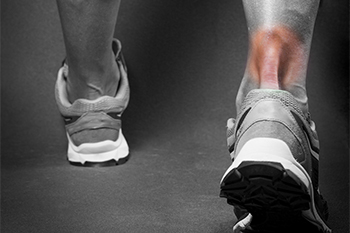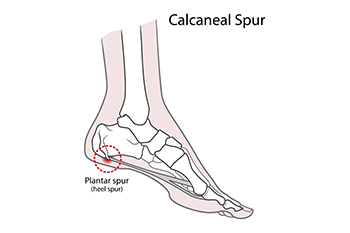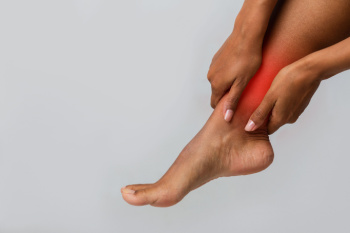Items filtered by date: November 2024
Reminder: When Was the Last Time...?
Achilles Tendon Injuries in Young People

Achilles tendon injuries are uncommon in pediatric and adolescent populations but can require surgery in severe cases, such as complete ruptures or deep lacerations. These injuries can occur during sports or accidents, especially in active teens, although young tendons are typically resilient and heal well with conservative care. Surgery is usually reserved for complex or complete tears that cannot heal adequately on their own. Despite being rare, surgical repair generally has positive outcomes for young patients, with most regaining full function and mobility following rehabilitation. Recovery includes targeted exercises to restore strength, flexibility, and balance, reducing the risk of re-injury. If your child has incurred an Achilles tendon injury, it is strongly suggested that you have it evaluated by a podiatrist to determine the best course of action and ensure a safe, effective return to activity for the growing foot and tendon structure.
Achilles tendon injuries need immediate attention to avoid future complications. If you have any concerns, contact Brandon M. Zuklie, DPM of New Jersey. Our doctor can provide the care you need to keep you pain-free and on your feet.
What Is the Achilles Tendon?
The Achilles tendon is a tendon that connects the lower leg muscles and calf to the heel of the foot. It is the strongest tendon in the human body and is essential for making movement possible. Because this tendon is such an integral part of the body, any injuries to it can create immense difficulties and should immediately be presented to a doctor.
What Are the Symptoms of an Achilles Tendon Injury?
There are various types of injuries that can affect the Achilles tendon. The two most common injuries are Achilles tendinitis and ruptures of the tendon.
Achilles Tendinitis Symptoms
- Inflammation
- Dull to severe pain
- Increased blood flow to the tendon
- Thickening of the tendon
Rupture Symptoms
- Extreme pain and swelling in the foot
- Total immobility
Treatment and Prevention
Achilles tendon injuries are diagnosed by a thorough physical evaluation, which can include an MRI. Treatment involves rest, physical therapy, and in some cases, surgery. However, various preventative measures can be taken to avoid these injuries, such as:
- Thorough stretching of the tendon before and after exercise
- Strengthening exercises like calf raises, squats, leg curls, leg extensions, leg raises, lunges, and leg presses
If you have any questions please feel free to contact our offices located in Piscataway, Jamesburg, and Branchburg, NJ . We offer the newest diagnostic tools and technology to treat your foot and ankle needs.
Causes and Relief Options for Toenail Fungus

Toenail fungus, medically known as onychomycosis, is a common infection that affects the nail bed, often starting as a white or yellow spot under the nail. Over time, it can cause nails to thicken, discolor, crumble, or become misshapen, leading to discomfort, and, in some cases, pain. Toenail fungus thrives in warm, moist environments, making athletes, individuals who sweat heavily, and those who wear tight or non-breathable shoes more susceptible. Poor foot hygiene and minor nail injuries also increase risk. Treating toenail fungus can be challenging, as the infection tends to be persistent. For more stubborn infections, it is suggested that you schedule an appointment with a podiatrist who may prescribe oral antifungal medications or laser therapy to target the fungus.
If left untreated, toenail fungus may spread to other toenails, skin, or even fingernails. If you suspect you have toenail fungus it is important to seek treatment right away. For more information about treatment, contact Brandon M. Zuklie, DPM of New Jersey. Our doctor can provide the care you need to keep you pain-free and on your feet.
Symptoms
- Warped or oddly shaped nails
- Yellowish nails
- Loose/separated nail
- Buildup of bits and pieces of nail fragments under the nail
- Brittle, broken, thickened nail
Treatment
If self-care strategies and over-the-counter medications does not help your fungus, your podiatrist may give you a prescription drug instead. Even if you find relief from your toenail fungus symptoms, you may experience a repeat infection in the future.
Prevention
In order to prevent getting toenail fungus in the future, you should always make sure to wash your feet with soap and water. After washing, it is important to dry your feet thoroughly especially in between the toes. When trimming your toenails, be sure to trim straight across instead of in a rounded shape. It is crucial not to cover up discolored nails with nail polish because that will prevent your nail from being able to “breathe”.
In some cases, surgical procedure may be needed to remove the toenail fungus. Consult with your podiatrist about the best treatment options for your case of toenail fungus.
If you have any questions, please feel free to contact our offices located in Piscataway, Jamesburg, and Branchburg, NJ . We offer the newest diagnostic and treatment technologies for all your foot care needs.
Understanding Heel Spurs

Heel spurs are bony protrusions that develop on the underside of the heel bone, or calcaneus, often as a result of repeated stress and strain on the foot. Common causes include plantar fasciitis, excessive running or walking, and wearing improper footwear. Heel spurs can also be associated with obesity and certain medical conditions, such as arthritis. Symptoms of heel spurs typically include sharp pain in the heel, especially when taking the first steps in the morning or after prolonged sitting. The discomfort may lessen with movement but can worsen throughout the day. A podiatrist can diagnose heel spurs through a physical exam and imaging tests like X-rays. Treatment options include rest, stretching exercises, and custom orthotics to alleviate pressure. In more severe cases, corticosteroid injections or surgery may be considered. If you are experiencing heel pain or suspect heel spurs, it is suggested that you schedule an appointment with a podiatrist for an accurate diagnosis and effective treatment plan.
Heel spurs can be incredibly painful and sometimes may make you unable to participate in physical activities. To get medical care for your heel spurs, contact Brandon M. Zuklie, DPM from New Jersey. Our doctor will do everything possible to treat your condition.
Heels Spurs
Heel spurs are formed by calcium deposits on the back of the foot where the heel is. This can also be caused by small fragments of bone breaking off one section of the foot, attaching onto the back of the foot. Heel spurs can also be bone growth on the back of the foot and may grow in the direction of the arch of the foot.
Older individuals usually suffer from heel spurs and pain sometimes intensifies with age. One of the main condition's spurs are related to is plantar fasciitis.
Pain
The pain associated with spurs is often because of weight placed on the feet. When someone is walking, their entire weight is concentrated on the feet. Bone spurs then have the tendency to affect other bones and tissues around the foot. As the pain continues, the feet will become tender and sensitive over time.
Treatments
There are many ways to treat heel spurs. If one is suffering from heel spurs in conjunction with pain, there are several methods for healing. Medication, surgery, and herbal care are some options.
If you have any questions feel free to contact our offices located in Piscataway, Jamesburg, and Branchburg, NJ . We offer the latest in diagnostic and treatment technology to meet your needs.
Possible Causes of Ankle Pain

Ankle pain is a frequent complaint with various underlying causes, often resulting from injury or overuse. One of the most common causes is a sprained ankle, which occurs when the ligaments are overstretched or torn, usually from twisting the foot. Tendonitis, especially involving the Achilles tendon, can also cause significant pain due to inflammation from overuse or sudden increases in physical activity. Arthritis, including osteoarthritis and rheumatoid arthritis, can lead to chronic ankle pain, stiffness, and swelling. Stress fractures, tiny cracks in the ankle bones that can happen from repetitive activities or excessive weight-bearing, are another frequent culprit. Ankle impingement, where soft tissues become compressed, may cause pain, particularly with certain movements. Additionally, gout, a form of arthritis caused by uric acid buildup, can trigger sudden, intense ankle pain. If you have ankle pain that is not getting better, it is suggested that you consult a podiatrist for a proper diagnosis and treatment solutions.
Ankle pain can be caused by a number of problems and may be potentially serious. If you have ankle pain, consult with Brandon M. Zuklie, DPM from New Jersey. Our doctor will assess your condition and provide you with quality foot and ankle treatment.
Ankle pain is any condition that causes pain in the ankle. Due to the fact that the ankle consists of tendons, muscles, bones, and ligaments, ankle pain can come from a number of different conditions.
Causes
The most common causes of ankle pain include:
- Types of arthritis (rheumatoid, osteoarthritis, and gout)
- Ankle sprains
- Broken ankles
- Achilles tendonitis
- Achilles tendon rupture
- Stress fractures
- Bursitis
- Tarsal tunnel syndrome
- Plantar fasciitis
Symptoms
Symptoms of ankle injury vary based upon the condition. Pain may include general pain and discomfort, swelling, aching, redness, bruising, burning or stabbing sensations, and/or loss of sensation.
Diagnosis
Due to the wide variety of potential causes of ankle pain, podiatrists will utilize a number of different methods to properly diagnose ankle pain. This can include asking for personal and family medical histories and of any recent injuries. Further diagnosis may include sensation tests, a physical examination, and potentially x-rays or other imaging tests.
Treatment
Just as the range of causes varies widely, so do treatments. Some more common treatments are rest, ice packs, keeping pressure off the foot, orthotics and braces, medication for inflammation and pain, and surgery.
If you have any questions, please feel free to contact our offices located in Piscataway, Jamesburg, and Branchburg, NJ . We offer the newest diagnostic and treatment technologies for all your foot care needs.

